

Want to Explore Suhzou? Please contact: Miss Jiang- wayfare10@163.com.
Suzhou, known as the "Venice of the East," is one of the oldest cities in the Yangtze Basin, with a history dating back over 2,500 years. The city was originally established as Helü in the Kingdom of Wu in 514 BC and served as a center for administration and commerce in the rice trade. Suzhou greatly benefited from the construction of the Grand Canal, which was completed in the early 7th century and strategically positioned the city.
During the Song Dynasty (960–1279 AD) and the Yuan Dynasty (1206–1368), Suzhou experienced a period of flourishing growth. Today, Suzhou offers a unique and unforgettable experience to visitors.

In the 13th century, the Venetian traveler Marco Polo visited Suzhou and praised its splendors, describing it as a magnificent and noble city with elegant canals and bridges. He mentioned the city's production of fine silks and its population of craftsmen, philosophers, and merchants.
Suzhou quickly became a hub for scholars, the arts, and commerce, serving as an important source of capital and a center for finance and banking. The cultivation of silk worms played a significant role in the city's success story.
Historians have found evidence of silk production in the region dating back to the Bronze Age, as seen in stone artifacts. As weaving skills and techniques developed alongside expanding trade routes, the Silk Roads were established, reaching distant destinations such as Japan, Persia, Greece, and Rome. During the Ming (1368–1644) and early Qing (1644–1912) dynasties, Suzhou's prominence grew among wealthy landowning families.
Symbols of that wealth can be seen today in Suzhou's collection of classical gardens, which have been well-preserved since the Ming and Qing dynasties. Out of the original 200 gardens dating back to the 11th century, 50 have survived, and nine of them have been honored with UNESCO World Heritage Site status. The Humble Administrator's Garden, Lingering Garden, Master-of-Nets Garden, Mountain Villa with Embracing Beauty, Blue Wave Pavilion, Lion Grove Garden, Couple's Garden, Garden of Cultivation, and Garden of Retreat and Reflection showcase refined sophistication through symbolism meticulously designed by landscape and waterscape masters.
In 1981, Suzhou City was listed by the State Council as one of the four cities with historical and cultural heritage protection. As a result, the city has developed into one of China's most prosperous destinations, attracting a growing number of tourists. In the 1990s, two major industrial parks were established: the Singapore Industrial Park (SIP) and the Suzhou New District. These parks have attracted numerous Fortune 500 corporations, with 20 percent of them having established a presence in Suzhou. In 2014, the Grand Canal was inscribed on UNESCO's World Heritage List. Suzhou is also home to renowned museums such as the Suzhou Silk Museum, Suzhou Museum of Opera and Theatre, and the Suzhou Museum, which was designed by the internationally renowned native architect, I.M. Pei.
Today, Suzhou's population and economy are among China's fastest-growing. Being only 60 miles away from Shanghai, the world's largest metropolitan area, commuting is made easier with the bullet train, which allows for a 25-minute journey between the two cities.
Humble Administrator’s Garden
Dating back to 1509, this renowned garden, which has been designated a UNESCO World Heritage Site and is counted among China's famous classical gardens, is the largest in Suzhou and is considered one of the greatest examples of quintessential Chinese landscape design. Walk across interlacing bridges as they guide you to the garden's enchanting water features, celebrated relics, and well-preserved pavilions. Indulge in tea at the garden's teahouse and don't forget to visit the museum for further historical insights.
Location: Gusu District — 178 Dongbei Street, Suzhou
Hours: 7:30 a.m. – 5:30 p.m. (Mar. 1–Nov. 15) / 7:30 a.m. – 5 p.m. (Nov. 16–Feb. 29)
Admission: ¥70 (Jan.–Mar., June, Nov.–Dec.) / ¥90 (Apr.–May, July–Oct.)
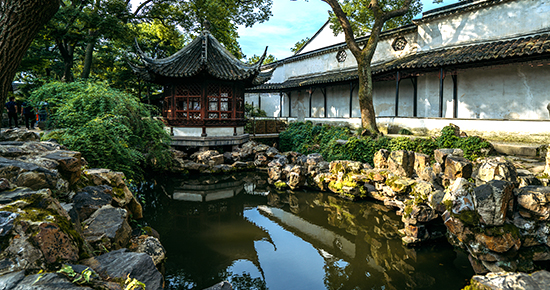
Lingering Garden
Built in 1593 and renowned for its breathtaking architecture, Lingering Garden is also a UNESCO World Heritage Site, covering an area of nearly nine square miles (23.31 sq km). Divided into four distinct themed sections - East, West, Central, and North - each area serves a unique purpose and can be explored through a connecting corridor adorned with ancient inlaid calligraphy.
Location: Gusu District — 338 Liuyuan Road, Suzhou
Hours: 7:30 a.m. – 5 p.m.
Admission: ¥45 (Jan.–March, June, Nov.–Dec.) / ¥55 (April–May, July–Oct.)

Master of the Nets Garden
It may be the smallest of Suzhou's Classical Gardens, but the Master of the Nets Garden packs a grand punch. This gem, dating back to the 12th century and later refurbished in the 18th century, is a UNESCO World Heritage Site and is renowned for its impressive garden and nightly Kunqu opera performances. However, its architectural splendor is what truly stands out. An intricate maze of rooms leads to windows and gateways that perfectly frame the courtyards and gardens beyond, creating the illusion of a much larger space. If it looks familiar, that's because it is. The Ming Hall Garden at New York's Metropolitan Museum of Art is modeled after the Master of the Nets Garden.
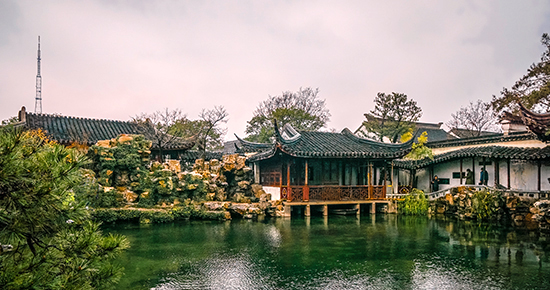
Location:Gusu District — No 1, Kuo JIa Tou Lane, Suzhou
Hours: 7:30 a.m. – 5:30 p.m. (Apr. 16–Oct. 30) / 7:30 a.m. – 5 p.m. (Oct. 31–Apr. 15) / 7:30 p.m. – 10 p.m. (Mid-Mar.–Mid-Nov.)
Admission: ¥30 (Jan.–Mar., June, Nov.–Dec.) / ¥40 (Apr.–May, July–Oct.) / ¥100 night tour (Mid-Mar.–Mid-Nov.).
Lion Grove Garden
Renowned for its multi-story rock maze that reaches a height of nearly 23 feet (7 m), the Master of the Nets Garden is also one of the nine Suzhou gardens that have been designated as UNESCO World Heritage Sites. Be amazed by the garden's renowned artificial mountains, which feature deep caves and whimsical limestone rock formations sourced from the nearby Taihu Lake. Admire the stunning architecture of the pavilions and delve into the backstory of each one. Make sure not to overlook the majestic waterfall and ancient trees that adorn the grounds.

Location: Gusu District — 23 Yuanlin Road, Suzhou
Hours: 7:30 a.m. – 5:30 p.m. (March 1 to October 15) / 7:30 a.m. – 5 p.m. (October 16 - End of February)
Admission: ¥30 (Oct. 31–Apr. 15) / ¥40 (Apr. 16–Oct .30)
Tiger Hill
According to legend, in 496 B.C., three days after the King of Wu buried his father atop this hill, a white tiger appeared and guarded the tomb. With a rich history and folklore, the ancient poet Su Dongpo described this popular attraction by saying, "to visit Suzhou and not see Tiger Hill would lead to a lifetime of regret." As you approach, you cannot miss the cultural symbol of Suzhou, the Yunyan Pagoda (also known as Huqiu Tower) - the park's towering thousand-year-old pagoda famous for its distinctive lean. After admiring its height, cast your eyes downward to the Sword Pool, believed to be the king's final resting place... for his swords. It only takes one visit to Tiger Hill to understand what Su Dongpo meant.
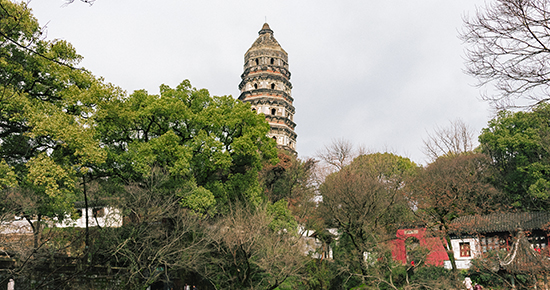
Location: Gusu District — 585 Huqiu Hill, Suzhou
Hours: 7:30 a.m. – 5:30 p.m.
Admission: ¥60 (January - March, June, November - December) / ¥80 (April, May, July - October)
Water Towns
Escape the hustle and bustle of the city by taking a trip to the quintessential countryside of Suzhou - its water towns. Living up to the nickname "Venice of the East," Suzhou's water towns are among the oldest and most charming in the world. One such town is Zhouzhuang, located in Kunshan City along the lower reaches of the Yangtze River and Taihu Lake. It is as enchanting as a fairytale, with impeccably preserved residential architecture, stone bridges, winding canals, and colorful traditions. Zhouzhuang is a destination that never fails to impress.
Location: Kunshan City, Suzhou
Hours: 8 a.m. – 9 p.m.
Admission: ¥100 (8 a.m. – 4 p.m.) / ¥80 (4 – 9 p.m.)
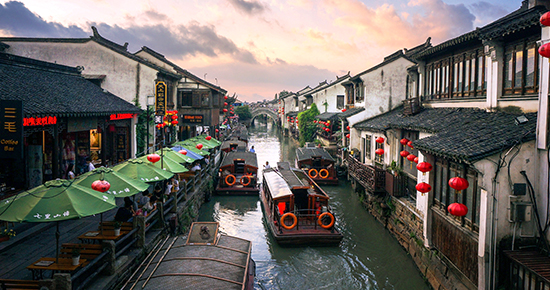
Another top destination is the ancient water town of Tongli, located in the Wujiang District along Taihu Lake. This thousand-year-old town is renowned for its sacred bridges, with the most famous ones being Taiping (peace), Jili (luck), and Changing (celebration). In addition to the bridges, Tongli is adorned with hundreds of gardens, temples, and mansions. Whether you choose to visit Zhouzhuang or Tongli (or both), the best way to immerse yourself in the charm of Suzhou's water towns is by taking a leisurely gondola ride.
Location: Wujiang District — No. 1 South Zhongshan Road, Suzhou
Hours: 7 a.m. – 9 p.m.
Admission: ¥100 (day) / ¥50 (evening)
Hanshan Temple
Hanshan Temple, considered one of the ten great temples in China, was constructed during the Qing dynasty (1644-1911), while its original architecture dates back to the Southern dynasty (502-557). With a history of over 1,500 years, Hanshan Temple, also known as Cold Mountain Temple, is a must-visit attraction. It gained fame through the poem "Mooring for the Night at Fengqiao Bridge," and its annual 108-bell-ringing ceremony on New Year's Eve has become a cherished tradition for both locals and visitors. If you happen to visit outside of holidays, don't miss the opportunity to climb to the top of the pagoda, as it offers breathtaking views of the city.
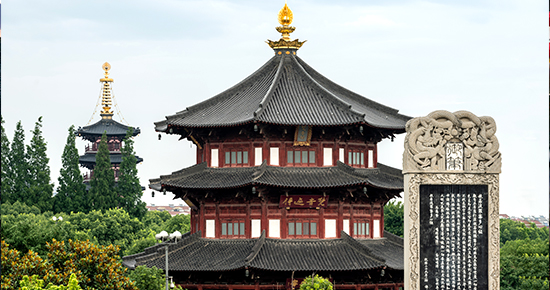
Location: Gusu District — No. 24, Hanshan Temple Alley, Fengqiao, Suzhou
Hours: 7:30 a.m. – 5:30 p.m.
Admission:¥20
Museums
What better way to immerse yourself in over 2,500 years of history than by visiting one of Suzhou's fascinating museums. Thanks to Suzhou's dedication to preserving its culture and heritage, the city boasts a wide variety of enriching museums. One aspect that holds significant importance in Suzhou's cultural fabric is its longstanding history of silk production. At the Suzhou Silk Museum, visitors can witness the entire lifecycle of silk production, from harvesting the silk (by rearing silkworms and collecting cocoons) to preparing the silk and ultimately spinning it into thread. Watching the skilled artisans at work is a captivating experience that offers insights into the traditional art of silk-making.
Location: Gusu District — No. 2001, Renmin Road, Suzhou
Hours: 9 a.m. – 5 p.m.
Admission: ¥15
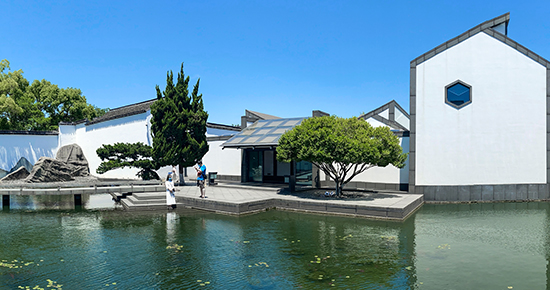
Designed by renowned local architect I.M. Pei and completed in 2006, the Suzhou Museum is the largest museum in the city. It beautifully displays the rich cultural heritage of the area. The museum's architecture takes inspiration from Suzhou's Classical Gardens, incorporating elements of water and bamboo into its design. This makes it a treat for both art enthusiasts and architecture lovers. Inside, the museum boasts a vast collection of over 15,000 pieces, including ancient paintings, elaborate calligraphy, porcelain crafts, and unearthed relics. Visitors will be captivated by the diverse exhibits that showcase the depth and beauty of Suzhou's cultural heritage.
Location: Gusu District — No. 204 Dongbei Street, Suzhou
Hours: 7:30 a.m. – 5 p.m. (closed Mondays)
Admission: Free (¥100 for a docent-led tour in English or ¥30 for an audio tour)
Sightseeing Along Suzhou’s Historic Streets
Set out on foot (or bike) to discover Suzhou’s storied landmarks and hidden gems. For a trip back in time, head to Shantang Street, famous for its old temples, ancestral halls and memorial arches. For an even richer blast to the past, stroll along Shiquan Street to discover architecture from the Ming and Qing dynastiesy, as well as the popular Nanlin Restaurant and Hotel and the commanding Master of the Nets Garden. Sample dumplings and confections on Guanqian Street, or enjoy Suzhou’s most delicious export at a local teahouse along Pingjiang Street. Along the way, be sure to admire the narrow canal, stone bridges and charming, whitewashed homes. Modern shoppers rejoice — Jinchang District’s Shilu Shopping Street provides a bevy of retail and department store goodies, and the shops even stay open until 10 p.m. Whether you’re exploring the city’s deep-rooted history or you’re in need of a major shopping fix, Suzhou’s streets are the place to go.
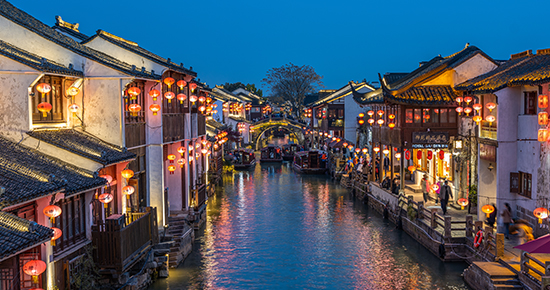
Suzhou Industrial Park (SIP)
Suzhou Industrial Park — or SIP — is the epicenter of modern-day Suzhou. Boasting hundreds of contemporary hotels, shops and restaurants, SIP is also home to several modern marvels, including Jinji Lake, the largest inland city lake in China, the Suzhou International Expo Center, two manmade islands (Peach Blossom Island and Exquisite Island), the largest Ferris wheel in Asia and a musical fountain and water curtain that doubles as a movie screen — the largest waterscape engineering feat in eastern China. If you happen to be in town on Friday or Saturday, don’t miss the 30-minute-long show that begins at 8 p.m.

Discover Suzhou Silk
Discover some of the magic at the Suzhou Embroidery Research Institute With a rich history dating back thousands of years, silk making is one of the key elements of Suzhou’s distinct cultural identity. In fact, Suzhou silk and weaving techniques including Kesi, Double-Sided Embroidery, Cloud Brocade and Song Brocade, have been recognized as elements of significant cultural heritage.
History of Suzhou Silk
Along with its enchanting canals and elegant gardens, Suzhou is also renowned for its exquisite silk. It is said that in the years of 3,000 BC, a cocoon fell into the tea cup of Lady Hsi-Lin-Shih – the wife of Yellow Emperor Huangdi. She was unable to unravel the wet pod into a single strong thread and eventually taught the locals how to raise silkworms for silk production. In fact, archaeological sites along the Yangzi River have revealed ancient spinning tools and silk thread and fabric dating back to 3630 – from the Chinese Neolithic period.
Traditionally, silk was originally reserved for Chinese emperors, but once its use spread to the entire ruling class and then to the gentry, silk cultivation became an integral part of Suzhou’s economy eventually leading it to become the epicenter of silk cultivation as the city’s fortunes grew with the expansion of global trading along the Silk Road.
Did You Know?
For nearly 3,000 years, Chinese artisans kept the silk-making processes a closely guarded secret.

Where To Discover Suzhou Silk
Trace the story and culture of silk from the legendary Chinese empress Leizu – said to have discovered silk when a cocoon dropped into her teacup in the 27th century B.C. – to the latest silk-manufacturing innovations and runway fashions. Then check out silkworms munching on their staple diet of mulberry leaves, watch silk being spun on old-fashioned looms and learn how to identify high quality genuine silk.
The Suzhou Silk Museum is housed in a contemporary building inspired by the city’s most famous export. The museum’s white-as-silk exterior is decorated with a distinctive cocoon pattern and boasts a striking outdoor art installation made from thin strands of white metal that hang from a lattice canopy like silk fibers drying in the sun. Inside, the museum is comprised of 102,000 square feet of stylish galleries, working silk-making facilities, a hands-on children’s museum and a world-class silk shop.
Start your self-guided tour in the Ancient Exhibit Hall and witness the development of silk production from the late Neolithic Age through the Ming and Qing dynasties. Ancient silk garments, tapestries and brocade, as well as reproductions of early silk patterns, bring the displays to life, while the museum’s extensive English signage puts the exhibitions in context and provides deeper meaning.
After seeing so many examples of elegant textiles, you’ll naturally wonder how such intricate fabric is produced. The answer is revealed in the museum’s Silkworm-Rearing Room and Silk Weaving Workshop — but before heading there, here’s a quick primer: Silkworm farmers collect eggs from adult silk moths, and once they hatch, the larvae feast on mulberry leaves for about six weeks. The larvae then secrete strands of silk for three to eight days as they wrap themselves in cocoons. Before the worms start transforming into pupae, the cocoons are dropped into boiling water, where the individual raw silk fibers can be extracted and spun together into thread. From there, the silk is further processed to make the fine thread used in high-end products.
Considered by many to be the highlight of the Suzhou Silk Museum, the Silkworm-Rearing Room offers visitors the simple pleasure of seeing silkworms munch on mulberry leaves. Combined with scenes of late Qing dynasty-era peasants breeding silkworms that also explain the silk-making process, it’s easy to imagine what life was like for silkworm farmers during Suzhou’s silk-production heyday. Continue to the Silk-Weaving Workshop to see silk thread become finished products. Here you can see traditional silk-weaving technology in action as women in ancient costumes demonstrate a variety of ancient looms and weave renowned silk products like brocades, green silk and velvet.
At the No.1 Silk Factory, visitors can experience the entire silk making process straight from the cocoon. This 100 year-old silk mill gives visitors the unique chance to follow the journey of tiny silkworms as they produce the fibers that ultimately become luxurious scarves, neckties, quilts and more.
This historic factory was established in 1926 and has since become a honored century-old factory in Suzhou. In fact, it was even recommended by BBC Travel as one of the best spots to visit to learn about the traditional skills of silk-making, and the culture and history behind silk in China. The factory has an extensive shop featuring apparel, accessories, home and beauty products, and more.
Did You Know?
It is estimated that the origins of approximately 80 percent of the world’s silk wedding dresses can be traced to Suzhou.
Nestled in the Mountain Villa of Secluded Beauty, one of Suzhou’s famed classical gardens, the Suzhou Embroidery Research Institute was established in 1957 and serves as the studio for more than 100 specialized embroidery artists dedicated to the preservation of this intricate artform.
Suzhou embroidery is characterized by beautiful patterns, elegant colors, and meticulous stitching patterns. The institute is a fascinating attraction for travelers who love not only history and culture, but also fashion and art, and have interest in seeing its creation first-hand.
In the world of Suzhou silk, there is one name that stands out among the rest: Qian Xiaoping. As a master of Song Brocade, which originated from the Song Dynasty in 960 - 1279, Qian Xiaoping is a pioneer and master in her artform.
Visitors to her workshop can learn how she creates her exquisite designs and commission bespoke silk apparel. What better way to commemorate your trip to Suzhou than in ultimate luxury!
Insider Tips For Exploring Silk in Suzhou
• Check out the cocoons that are sold as facial exfoliators in the Suzhou Silk Museum shop. They are a wonderful natural, organic skincare product unique to Suzhou.
• Pick up a luxurious custom-made embroidery pieces as a souvenir at the Suzhou Embroidery Research Institute.
• At the end of your tour at No.1 Silk Factory, try your hand at making a quilt. With the help of workers or other guests, everyone will grab a bundle of silk from one corner and stretch it as far as possible without breaking it. It will then settle down on top of hundreds of other layers of the same stretched silk which will eventually be turned into a handmade silk quilt!
• Combine your visit to the Suzhou Silk Museum with the nearby North Temple Pagodaor double your museum pleasure by also visiting the I.M. Pei-designed Suzhou Museum just minutes away.
• If you’re visiting Suzhou anytime from late September to mid-October, make sure to check out the China Suzhou International Silk Festival.
Kunqu Opera
Kunqu Opera, originally known as "Kunshan Qiang" (or "Kun Qiang" for short), is an ancient form of Chinese theatrical performance, also referred to as "Kunju." Amongst the various traditional Chinese operas, Kunqu Opera is one of the oldest and most cherished art forms of Han ethnicity, often compared to a "lantern flower" in a garden of diverse talents. Originating in the 14th century in Kunshan, Suzhou, Kunqu Opera spread nationwide through the improvements made by Wei Liangfu and other artists, dominating the Chinese theatrical stage for nearly 300 years since the mid-Ming Dynasty. Combining singing, speaking, acting, dancing, and martial arts, Kunqu Opera is renowned for its elegant melodies, graceful vocal delivery, and exquisite performances. It is regarded as one of the foundational opera genres within the Southern School, often hailed as the ancestor of all theatrical arts. Rhythm is controlled through drums and clappers, accompanied predominantly by instruments such as a flute and sanxian. Its unique vocal style follows the "Zhongzhou dialect." A visit to Suzhou would be incomplete without witnessing the unforgettable beauty of a Kunqu Opera performance!

Venue recommendations:
1. Suzhou Kunqu Opera Theater in Jiangsu Province
Operating hours: Monday to Sunday, 09:00-22:00
Address: No. 9 Pingmen School, Changqiao Road, Gusu District, Suzhou
Telephone: 67535255
2. Fuxi Hall
Operating hours: Monday to Sunday, 13:00-23:00
Address: No. 97 Pingjiang Road, Gusu District, Suzhou
Telephone: 65812905
3. Shantang Kunqu Opera Museum
Operating hours: Monday to Sunday, 9:30-22:00
Address: No. 45, Xiatang, Tougui Bridge, Shantang Street, Gusu District, Suzhou
Telephone: 65313936
Tour A: Suzhou Gardens & Waterways Full Day Tour
Leaving behind the bustling city life in Shanghai we drive 2 hours to Suzhou explore some of the enchanting gardens and canals and the long famed silk production center of the region. To appreciate the delicate sense of aesthetics that goes into creating traditional Chinese gardens we visit the impressive Master of Nets Garden and Humble Administrators Garden. Continuing our tour we pay a visit to Silk Factory, and take a pleasant walk along Shan Tang Street which is Ming & Qing Dynasty style with various kinds of food and folk arts. Return transfer to hotel in Shanghai at around 7pm.
Tour B: Zhouzhuang Water Town and Suzhou Gardens & 2 Days Tour
Day 1
This morning you will be met at your hotel at approximately 9.00am for a full day tour to Zhouzhuang Ancient Water Town. Get a glimpse of the ancient Chinese canal town of Zhujiajiao which takes 1.5 hours to drive from Shanghai downtown, dating back to the Ming and Qing dynasties. We stroll the backstreets, cruise the canals and absorb the charming old world atmosphere. After lunch at local restaurant, we will have further touring to visit Double Bridge, Zhang’s House. Leaving behind the ancient Zhouzhuang Village, we drive 1 hour to Suzhou. Check in hotel in Suzhou and have a rest. Tonight we will have a night tour to Master of the Nets Garden to enjoy folk opera show in the Garden.
Day 2
To appreciate the delicate sense of aesthetics that goes into creating traditional Chinese gardens we visit the impressive Lingering Garden and Humble Administrators Garden. Continuing our tour we pay a visit to Silk Factory, and talk a pleasant walk along Shan Tang Street which is of Ming & Qing Dynasty style with various kinds of food and folk arts. Return transfer to hotel in Shanghai.
Tour C: Shanghai City Full Day Tour
This morning you will be met at your hotel at approximately 9.00am for a full day tour of some of Shanghai's highlights. Our first stop is Pudong New Developed Area, we will visit the observation deck of Oriental Peal TV Tower including Shanghai History Museum on the bottom floor. Then we drive to Puxi and take a relaxing walk along the Bund. After lunch we will explore the Yu Garden and Bazaar of Ming Dynasty Style. Our last stop is Shanghai Museum, this is a collection of cultural items including ancient Chinese bronze, ceramics, painting and calligraphy. Return to Hotel at around 5pm.
Tour D: Wuzhen - Hangzhou and Yellow Mountain Escape 5 Days/4 Nights
Day 1 Arrive Hangzhou with Wuzhen Touring
Meet your local guide in the lobby of your hotel at 8.30a.m. Today you’ll leave the bright lights of Shanghai and drive to Wuzhen Water Town, one of the most beautiful water canal towns in China. After arrival, get to know the place best by exploring the canals on a relaxing cruise. Drive on to Hangzhou and its famed West Lake.
Day 2 Hangzhou - West Lake
Hangzhou’s attractions are manifold. Today we visit Feilai Feng, or ‘Flying Peak’, a place of stunning natural beauty. Later, explore Lingyin Si, the Temple of Soul’s Retreat, and the Longjing Tea Plantations – the area is famous for producing some of the best quality tea in China. West Lake’s serene waters are best explored on a boat cruise.
Day 3 Depart Hangzhou to Huangshan
We take fast train from Hangzhou to Huangshan, the train takes 2 hours only. Drive to the base of Yellow Mountain and take the scenic cable car to the summit where you will explore rock formations, rich greens of the alpine forest and small viewpoints. There will be plenty of walking and many stairs. Overnight in the hotel in Tunxi city.
Day 4 Xiuli Ancient Town and Hongcun Village
We drive to Yi County (黟县), to visit Xiuli Ancient Town, this is a popular place for a lot of well-known movies such as Crouching Tiger, Hidden Dragon. This afternoon we will continue to visit Hukai Ink Factory, which is a special local Intangible Cultural Heritage. Overnight in Yi County.
Day 5. Tour to Hongcun Village and Tunxi Old Street
Hongcun Village is located in the Southwest foot of Huangshan Mountain, and the town was built in South Song Dynasty with a history of 900 years. This afternoon we return to Tunxi City and have some free time exploring Tunxi Old Street where you can find lots of local food and souvenir. Return to Shanghai by G7314(1726/2030). Tour ends.